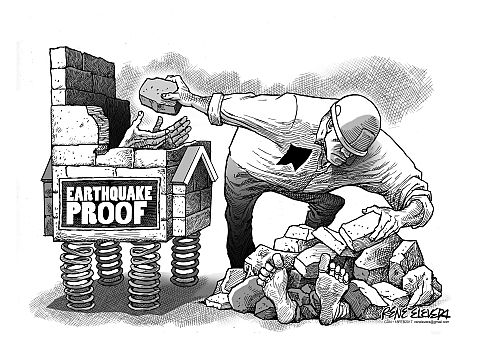
Last week’s earthquake that rocked Surigao is yet another reminder of the necessity to build better homes and buildings in the country if only to rebuild faster and protect one’s families from harm.
The 6.7-magnitude earthquake did its damage, and the first to fall were old buildings and aging infrastructures like the power and water supply systems that would be fully repaired by next month, barring any major aftershocks.
A lot of families were displaced and had to be calmed down and persuaded by local officials to temporarily seek refuge at the barangay halls amid misplaced fears of a tsunami that may sweep through the province hours after the quake.
The problem with the lot of us is that it doesn’t take long after the aftershocks subsides that we are back to our old ways, rebuilding with whatever we have and can afford with nary a thought on whether our houses and buildings can survive and withstand yet another major earthquake.
Truth be told, the only way we can survive an earthquake is if — and that’s a big IF — we can build cities that float in the air or orbit around the Earth.
But that’s the stuff of science fiction; and only developed nations have the technology, people and resources to make it happen, not us.
But if we can’t build better homes and buildings right here on the ground, the prospect of building floating or orbiting cities is about as remote as the possibility of us sending people to the moon, or to a lesser extent, the country hosting the Olympics.
So the first thing is to evaluate the status of our aging structures, and the Cebu City government actually did that two to three years ago when they assessed the old buildings in downtown Colon Street to determine if they can withstand medium- to high-intensity earthquakes.
Obviously, the results were far less encouraging. Some of these buildings, including a commercial outlet, were also found to have been built near a river, and as such, their uncollected and dumped wastes contributed to the clogging of the waterways.
But the flooding is another issue and one that’s left unattended. Right now, local governments should take the lead in encouraging and helping provide adequate and resilient housing to their constituents.
It doesn’t have to involve spending for their housing materials as well as technology though they can probably tap nongovernment organizations (NGOs) to help them do just that.
The Cebu provincial government is expected to finish its own emergency operations center that they said will serve as an example for calamity-resilient housing in the province.
While it’s nice to know they have one, we hope the province does more to provide and help their constituents build better, stronger, more resilient homes as well as require businesses to follow the law and build their own strong buildings that can withstand quakes and other calamities.
Disclaimer: The comments uploaded on this site do not necessarily represent or reflect the views of management and owner of Cebudailynews. We reserve the right to exclude comments that we deem to be inconsistent with our editorial standards.
